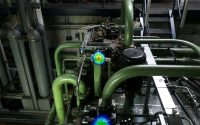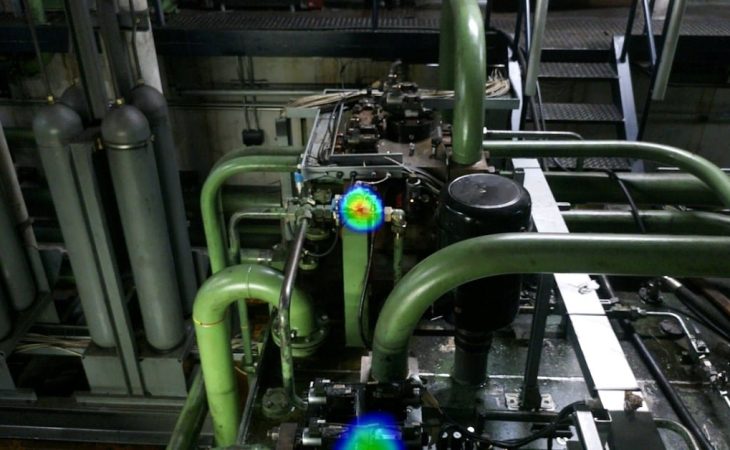Proper use and utilization of equipment, machines, and systems are significant factors in industrial and commercial applications that determine productivity per cost. On the other hand, improper use can result in extra energy utilization, poor performance, and high operation expenses. Air leak detectors with ultrasonic technology are the most reliable tools for detecting and locating such leaks. This technology uses high-frequency acoustical signals to identify gas leakage or air emanating from high-pressure systems.
In this article, we will discuss ultrasonic leak detection, how it operates, and the benefits of using ultrasonic air leak detectors.
Contents
Basis of Ultrasonic Leak Detection
Ultrasonic leak detection depends on the knowledge that when gas or air escapes from a pressurized system, it generates sound waves above the ultrasonic range, namely above 20 kHz. Whenever there is a pressure drop in a closed environment such as a building, there will be turbulence at the face of a leakage when the air or gas escapes, and this causes the production of ultrasonic sound waves. Most of these sound waves are inaudible to the human hearing system, implying that diagnosing leakages without appropriate tools is challenging.
Due to these leaks, high-frequency sound is produced, and the ultrasonic air leak detector is created to detect them. It transforms the ultrasonic signals into audibles that can be understood by the technicians. High-frequency sound is usually not audible to the human ears, but with the aid of this technology, leaks that are not easily detected are noticeable, hence increasing maintenance and operation.
The Technology Used in Ultrasonic leak detectors
Ultrasonic leak detectors consist of several key components. An example of a signal-converting device includes a transducer, signal processing circuit, and output display.
1. Transducer: As is with most instruments, the transducer is the central component in the ultrasonic leak detector. It identifies the ultrasonic sound waves that occur with escaping gas or air conditions. The high-frequency sound waves are converted to electrical signals, which transducers could dissect. One of the most critical considerations is the transducer element; it defines the detector’s capability to lock minimally strong ultrasonic signals from minor leaks.
2. Signal Processing Circuitry: After the transducer collects the ultrasonic sound waves, the signal processing circuit amplifies the received signals and filters them to isolate only the leak noise from other environmental noises. This circuitry improves the quality of the received signal, thus improving leak detection. Advanced detectors can also give information about when the signals were detected and the frequency and amplitude of the sounds detected.
3. Output Display: The output display that the technician gets is about the leakage. One option is to use LED lights or graphics to present the leakage and its intensity. Among some of the more complex models, there are audio output options that let the user hear the ultrasonic sounds it has identified, which would give more information about the nature of the leak.
Use of Ultrasonic Leak Detecting
Ultrasonic air leak detectors are used industrially in the manufacturing and automotive industries, pharmaceuticals, and food processing industries. Their applications include:
Compressed Air Systems: It is standard practice in the modern workplace for industries to use compressed air systems, but they need to realize that such systems’ systems are notorious for their leaks. Ultrasonic detectors often involve quick identification of the compressed air leaks in the pipelines, valves, and fittings, saving organizations a lot of money the escaping air would have used.
Vacuum Systems: Vacuum systems are used in many industry processes. Leakage results in major performance problems in these systems. Vacuum pipe, chamber, and seal equipment can, therefore, benefit from ultrasonic leak detectors for maximum efficiency in leak detection.
Gas Systems: They are also used to detect leakage from gassy systems such as natural gas pipeline systems. Such detectors play an important role in the gas industry because they should identify the presence and the point of gas leaks quickly to avoid potential dangers.
HVAC Systems: HVAC systems, or Heating, Ventilation, and Air conditioning systems, are vital to the air quality of the indoor environment. Lost HVAC leakage tests the health of both the ductwork and other HVAC components and can help maintain energy consumption and comfort in buildings.
Benefits of Ultrasonic Leak Detectors
The use of ultrasonic air leak detectors offers several significant advantages over traditional leak detection methods:
Speed and Efficiency: As an added benefit, ultrasonic detectors can identify the exact location of the leak without having to do a great deal of testing and take equipment offline. This efficiency leads to savings in person-hours and less interruption of business processes.
Accuracy: The other advantage of using the developed technology is the availability of high-frequency sound wave detection in noisy environments. It does this without resulting in false positives or false negatives, thus improving maintenance practices.
Non-Invasive Testing: Ultrasonic leak detection is not invasive at all, or in other words, it does not involve changing the position or structure of systems or components. This feature is most beneficial in environments where interruptions should be avoided, particularly in sensitive/critical ones.
Portability: Most ultrasonic leak detectors are small devices and quite portable. They can be moved from one place to another or used in different places, increasing their applicability in various uses and allowing them to be moved from one place to another as needed.
Cost-Effective
The approach of including and handling energy leaks may seem small, but if done effectively, it is a sure way of cutting down an organization’s energy costs within a short period. While implementing ultrasonic leak detection technology may involve a particular initial capital outlay, the cost of implementing it is considered less than the cost of using energy to identify leaks in other ways and carry out a repair in the long run.
Final Thoughts
Ultrasonic air leak detectors are one of the most effective tools for detecting and remedying air leaks in different industries and commercial businesses. These detectors use sound waves traveling at high frequency to locate leaks and, therefore, offer a fast, precise, and contactless technique of leak identification. Innovative technology and best practices of ULT increase functionality and productivity at production facilities and bring added advantages such as reducing costs and improving safety. In light of the growing focus of industries on energy conservation and rationalization of maintenance expenses, ultrasonic leak detectors will remain valuable tools that help protect pressurized systems and minimize avoidable expenses. Apart from maintaining organizational sustainability, using this technology contributes to the survivability and dependability of these systems.





